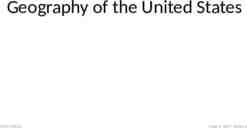The Tenure Review Process TENURE REVIEW COMMITTEE DR. SONJA LOLLAND
26 Slides1.34 MB
The Tenure Review Process TENURE REVIEW COMMITTEE DR. SONJA LOLLAND (VPAA) DR. ROMERO JALOMO (VPSA) LISA STORM (AS PRESIDENT) CHERYL O’DONNELL (AS VICE PRESIDENT)
Article 14 Governs the evaluation of probationary faculty Purpose: the principal purpose of the probationary faculty evaluation process, is: to improve the educational programs of the District; to recognize and acknowledge good performance; to assure compliance with District policies and procedures; to enhance satisfactory performance and help probationary faculty members further their own growth; to identify weak performance and assist employees in achieving needed improvement; to to document unsatisfactory performance, and assist the Governing Board in determining continued employment by the District.
It is a 4 Year Process Year 1 - The faculty member’s first year contract is based on initial hiring. Year 2 – The Board of Trustees (BOT) will recommend a 2nd one-year contract based on the recommendation of the Tenure Review Committee and the college President. Years 3 & 4 - At the end of year two, if all is satisfactory, the faculty member is offered a two-year contract. The faculty member is evaluated in each of the two years. However, there is no BOT decision in year three. Year 4 – the faculty member is either granted tenure, or not offered a new contract.
Four Layers to the Decision Layer one – Layer two – The Tenure Review Committee (VP of Academic Affairs, VP of Student Affairs, Academic Senate President, and Academic VP – or designees). Layer three – The evaluatee’s immediate team. The team can be one or two faculty members of choice, and the evaluatee’s supervisor. The college President. Layer four – The Board of Trustees (must be made by March 15th).
Timeline Evaluatee’s team named in spring (except in first year); Early fall semester – evaluation team meets with evaluatee; October 15th work site observations/student appraisals complete; December 10th reports by evaluatee submitted; November 15th Criteria of evaluation discussed, site visits scheduled; post-evaluation conference complete; March 15th
The Evaluation Team The appropriate administrator; One or two faculty peer members, chosen by the evaluatee and approved by the Academic Senate; Generally kept all four years, but can be changed “for good cause;” One peer should be from the discipline or closely related discipline; The Academic Senate may provide guidance if the evaluatee desires.
Evaluation Forms Links to work site observation reports and student appraisals are found here. Distance Education looks at one learning unit. Required Reports: Faculty Professional Growth Report College Related Activities Report Self Appraisal
Assessment Criteria Core duties: teaching; student advising and assistance; accurate and timely record-keeping and submission of reports; collegial collaboration in meetings and activities; collegial collaboration in college-wide activities; development and assessment of student learning and program level outcomes.
Assessment Criteria II Professional Competence: worksite observations are conducted to assess the professional competence of faculty members in all instructional and non-instructional settings; those competencies are listed in the worksite observation evaluation forms (see appendices, section C); written for particular roles, e.g., instructor (face-to-face and online), counselor, librarian, instructional specialist, coach, and athletic trainer.
Assessment Criteria III Professional Conduct: willingness to assist students; meets obligations from state mandates and District policies; acknowledges and defends free inquiry; works cooperatively and professionally with others; shows consideration for constructive feedback; evidences a willingness to investigate new ideas, methods, and techniques; avails self to opportunities for professional growth; demonstrates personal integrity and ethics of the profession.
Assessment Criteria IV Professional Growth: the comprehensive evaluation will also provide an opportunity for the evaluatee to: demonstrate his or her commitment to growing professionally, to improving teaching, to increasing proficiency in the discipline, and to being better prepared to support students and enhance their success. Examples of the activities that constitute professional growth are listed on the professional growth report form (see appendices, section C).
Assessment Criteria V COLLEGE RELATED ACTIVITIES: looks at service to the college, the District, and its students outside of assigned instructional duties: service on department and college committees; service on Academic Senate committees; service on participatory governance councils and committees; participation in recruiting and outreach activities; participation on articulation committees; coordination, advisement, and supervision of Hartnell student organizations or student activities; participation in organized student success efforts. participation in community service or community projects that positively reflect on the district;
Assessment Criteria VI Professional Goals: the comprehensive evaluation will also include an opportunity for the evaluatee to develop and assess one to three professional goals each evaluation cycle that will enhance the probationary faculty member’s ability to serve students and the campuswide community.
INSTRUCTIONAL MATERIALS Every syllabus for EVERY course taught during the evaluation semester should be provided. Syllabi should include the following: Course content and objectives from the course outline of record Student Learning Outcomes Clear grading criteria Reference relevant college policies (safety, drop dates, etc). Non-teaching roles – use materials that you have generated to perform your job.
Instructional Materials Provide samples of: study guides homework assignments quizzes examinations for all classes only course materials that you developed you may use items from your textbook publisher, but do not submit them as an example of your own work
Self Appraisal Set 1-3 goals: make the goals SMART – Specific Measurable Action oriented Realistic Time frame always one year until you are tenured, then it is every three.
Out With The Old, In With The New The Tenure Review process is being streamlined and organized for efficiency! Reports have been created to allow for clear and consistent input of information The requirement of binders is being phased out Timelines and expectations are being presented in a clear and concise manner for each member of the evaluation team
Three Reports Suggested Order of Completion Professional Growth Report College Related Activities Report Self-Appraisal Report Avoid Redundancy
Faculty Professional Growth Report
College Related Activities Report
Self-Appraisal Report
Quick Reference Guides
Requirements 1st Year Faculty 2nd, 3rd, and 4th Year Faculty Going digital is required Creating a binder is your choice! Regardless of year in the process, submission of digital reports and materials will be required. Everyone will receive a USB drive! USB drive will be turned in by all.
Moving Forward - Your New Binder
Questions?
We Are Here To Help! Lisa Storm, Academic Senate President Cheryl O’Donnell, Academic Senate First VP [email protected] [email protected] Nancy Schur-Beymer, Academic Senate Secretary [email protected]







